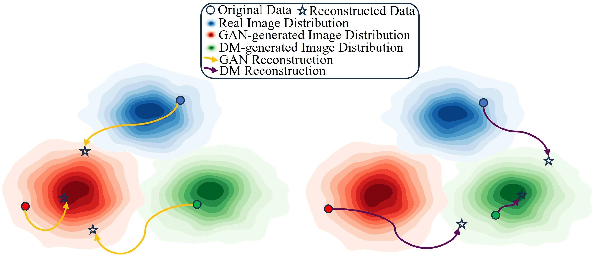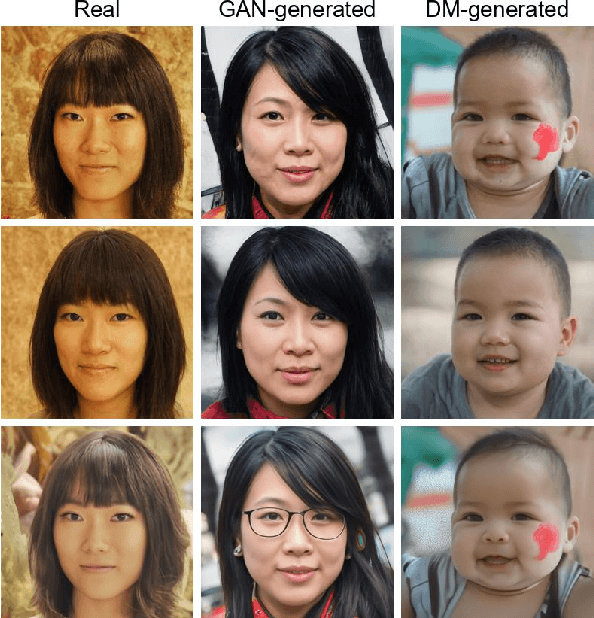Zhongjie Ba
FBA$^2$D: Frequency-based Black-box Attack for AI-generated Image Detection
Dec 10, 2025Abstract:The prosperous development of Artificial Intelligence-Generated Content (AIGC) has brought people's anxiety about the spread of false information on social media. Designing detectors for filtering is an effective defense method, but most detectors will be compromised by adversarial samples. Currently, most studies exposing AIGC security issues assume information on model structure and data distribution. In real applications, attackers query and interfere with models that provide services in the form of application programming interfaces (APIs), which constitutes the black-box decision-based attack paradigm. However, to the best of our knowledge, decision-based attacks on AIGC detectors remain unexplored. In this study, we propose \textbf{FBA$^2$D}: a frequency-based black-box attack method for AIGC detection to fill the research gap. Motivated by frequency-domain discrepancies between generated and real images, we develop a decision-based attack that leverages the Discrete Cosine Transform (DCT) for fine-grained spectral partitioning and selects frequency bands as query subspaces, improving both query efficiency and image quality. Moreover, attacks on AIGC detectors should mitigate initialization failures, preserve image quality, and operate under strict query budgets. To address these issues, we adopt an ``adversarial example soup'' method, averaging candidates from successive surrogate iterations and using the result as the initialization to accelerate the query-based attack. The empirical study on the Synthetic LSUN dataset and GenImage dataset demonstrate the effectiveness of our prosed method. This study shows the urgency of addressing practical AIGC security problems.
Model Discrepancy Learning: Synthetic Faces Detection Based on Multi-Reconstruction
Apr 10, 2025



Abstract:Advances in image generation enable hyper-realistic synthetic faces but also pose risks, thus making synthetic face detection crucial. Previous research focuses on the general differences between generated images and real images, often overlooking the discrepancies among various generative techniques. In this paper, we explore the intrinsic relationship between synthetic images and their corresponding generation technologies. We find that specific images exhibit significant reconstruction discrepancies across different generative methods and that matching generation techniques provide more accurate reconstructions. Based on this insight, we propose a Multi-Reconstruction-based detector. By reversing and reconstructing images using multiple generative models, we analyze the reconstruction differences among real, GAN-generated, and DM-generated images to facilitate effective differentiation. Additionally, we introduce the Asian Synthetic Face Dataset (ASFD), containing synthetic Asian faces generated with various GANs and DMs. This dataset complements existing synthetic face datasets. Experimental results demonstrate that our detector achieves exceptional performance, with strong generalization and robustness.
Imperceptible but Forgeable: Practical Invisible Watermark Forgery via Diffusion Models
Mar 28, 2025Abstract:Invisible watermarking is critical for content provenance and accountability in Generative AI. Although commercial companies have increasingly committed to using watermarks, the robustness of existing watermarking schemes against forgery attacks is understudied. This paper proposes DiffForge, the first watermark forgery framework capable of forging imperceptible watermarks under a no-box setting. We estimate the watermark distribution using an unconditional diffusion model and introduce shallow inversion to inject the watermark into a non-watermarked image seamlessly. This approach facilitates watermark injection while preserving image quality by adaptively selecting the depth of inversion steps, leveraging our key insight that watermarks degrade with added noise during the early diffusion phases. Comprehensive evaluations show that DiffForge deceives open-source watermark detectors with a 96.38% success rate and misleads a commercial watermark system with over 97% success rate, achieving high confidence.1 This work reveals fundamental security limitations in current watermarking paradigms.
Harnessing Frequency Spectrum Insights for Image Copyright Protection Against Diffusion Models
Mar 17, 2025Abstract:Diffusion models have achieved remarkable success in novel view synthesis, but their reliance on large, diverse, and often untraceable Web datasets has raised pressing concerns about image copyright protection. Current methods fall short in reliably identifying unauthorized image use, as they struggle to generalize across varied generation tasks and fail when the training dataset includes images from multiple sources with few identifiable (watermarked or poisoned) samples. In this paper, we present novel evidence that diffusion-generated images faithfully preserve the statistical properties of their training data, particularly reflected in their spectral features. Leveraging this insight, we introduce \emph{CoprGuard}, a robust frequency domain watermarking framework to safeguard against unauthorized image usage in diffusion model training and fine-tuning. CoprGuard demonstrates remarkable effectiveness against a wide range of models, from naive diffusion models to sophisticated text-to-image models, and is robust even when watermarked images comprise a mere 1\% of the training dataset. This robust and versatile approach empowers content owners to protect their intellectual property in the era of AI-driven image generation.
Towards Label-Only Membership Inference Attack against Pre-trained Large Language Models
Feb 26, 2025Abstract:Membership Inference Attacks (MIAs) aim to predict whether a data sample belongs to the model's training set or not. Although prior research has extensively explored MIAs in Large Language Models (LLMs), they typically require accessing to complete output logits (\ie, \textit{logits-based attacks}), which are usually not available in practice. In this paper, we study the vulnerability of pre-trained LLMs to MIAs in the \textit{label-only setting}, where the adversary can only access generated tokens (text). We first reveal that existing label-only MIAs have minor effects in attacking pre-trained LLMs, although they are highly effective in inferring fine-tuning datasets used for personalized LLMs. We find that their failure stems from two main reasons, including better generalization and overly coarse perturbation. Specifically, due to the extensive pre-training corpora and exposing each sample only a few times, LLMs exhibit minimal robustness differences between members and non-members. This makes token-level perturbations too coarse to capture such differences. To alleviate these problems, we propose \textbf{PETAL}: a label-only membership inference attack based on \textbf{PE}r-\textbf{T}oken sem\textbf{A}ntic simi\textbf{L}arity. Specifically, PETAL leverages token-level semantic similarity to approximate output probabilities and subsequently calculate the perplexity. It finally exposes membership based on the common assumption that members are `better' memorized and have smaller perplexity. We conduct extensive experiments on the WikiMIA benchmark and the more challenging MIMIR benchmark. Empirically, our PETAL performs better than the extensions of existing label-only attacks against personalized LLMs and even on par with other advanced logit-based attacks across all metrics on five prevalent open-source LLMs.
Robust Watermarks Leak: Channel-Aware Feature Extraction Enables Adversarial Watermark Manipulation
Feb 10, 2025



Abstract:Watermarking plays a key role in the provenance and detection of AI-generated content. While existing methods prioritize robustness against real-world distortions (e.g., JPEG compression and noise addition), we reveal a fundamental tradeoff: such robust watermarks inherently improve the redundancy of detectable patterns encoded into images, creating exploitable information leakage. To leverage this, we propose an attack framework that extracts leakage of watermark patterns through multi-channel feature learning using a pre-trained vision model. Unlike prior works requiring massive data or detector access, our method achieves both forgery and detection evasion with a single watermarked image. Extensive experiments demonstrate that our method achieves a 60\% success rate gain in detection evasion and 51\% improvement in forgery accuracy compared to state-of-the-art methods while maintaining visual fidelity. Our work exposes the robustness-stealthiness paradox: current "robust" watermarks sacrifice security for distortion resistance, providing insights for future watermark design.
FSFM: A Generalizable Face Security Foundation Model via Self-Supervised Facial Representation Learning
Dec 16, 2024Abstract:This work asks: with abundant, unlabeled real faces, how to learn a robust and transferable facial representation that boosts various face security tasks with respect to generalization performance? We make the first attempt and propose a self-supervised pretraining framework to learn fundamental representations of real face images, FSFM, that leverages the synergy between masked image modeling (MIM) and instance discrimination (ID). We explore various facial masking strategies for MIM and present a simple yet powerful CRFR-P masking, which explicitly forces the model to capture meaningful intra-region consistency and challenging inter-region coherency. Furthermore, we devise the ID network that naturally couples with MIM to establish underlying local-to-global correspondence via tailored self-distillation. These three learning objectives, namely 3C, empower encoding both local features and global semantics of real faces. After pretraining, a vanilla ViT serves as a universal vision foundation model for downstream face security tasks: cross-dataset deepfake detection, cross-domain face anti-spoofing, and unseen diffusion facial forgery detection. Extensive experiments on 10 public datasets demonstrate that our model transfers better than supervised pretraining, visual and facial self-supervised learning arts, and even outperforms task-specialized SOTA methods.
ALIF: Low-Cost Adversarial Audio Attacks on Black-Box Speech Platforms using Linguistic Features
Aug 03, 2024Abstract:Extensive research has revealed that adversarial examples (AE) pose a significant threat to voice-controllable smart devices. Recent studies have proposed black-box adversarial attacks that require only the final transcription from an automatic speech recognition (ASR) system. However, these attacks typically involve many queries to the ASR, resulting in substantial costs. Moreover, AE-based adversarial audio samples are susceptible to ASR updates. In this paper, we identify the root cause of these limitations, namely the inability to construct AE attack samples directly around the decision boundary of deep learning (DL) models. Building on this observation, we propose ALIF, the first black-box adversarial linguistic feature-based attack pipeline. We leverage the reciprocal process of text-to-speech (TTS) and ASR models to generate perturbations in the linguistic embedding space where the decision boundary resides. Based on the ALIF pipeline, we present the ALIF-OTL and ALIF-OTA schemes for launching attacks in both the digital domain and the physical playback environment on four commercial ASRs and voice assistants. Extensive evaluations demonstrate that ALIF-OTL and -OTA significantly improve query efficiency by 97.7% and 73.3%, respectively, while achieving competitive performance compared to existing methods. Notably, ALIF-OTL can generate an attack sample with only one query. Furthermore, our test-of-time experiment validates the robustness of our approach against ASR updates.
RedAgent: Red Teaming Large Language Models with Context-aware Autonomous Language Agent
Jul 23, 2024



Abstract:Recently, advanced Large Language Models (LLMs) such as GPT-4 have been integrated into many real-world applications like Code Copilot. These applications have significantly expanded the attack surface of LLMs, exposing them to a variety of threats. Among them, jailbreak attacks that induce toxic responses through jailbreak prompts have raised critical safety concerns. To identify these threats, a growing number of red teaming approaches simulate potential adversarial scenarios by crafting jailbreak prompts to test the target LLM. However, existing red teaming methods do not consider the unique vulnerabilities of LLM in different scenarios, making it difficult to adjust the jailbreak prompts to find context-specific vulnerabilities. Meanwhile, these methods are limited to refining jailbreak templates using a few mutation operations, lacking the automation and scalability to adapt to different scenarios. To enable context-aware and efficient red teaming, we abstract and model existing attacks into a coherent concept called "jailbreak strategy" and propose a multi-agent LLM system named RedAgent that leverages these strategies to generate context-aware jailbreak prompts. By self-reflecting on contextual feedback in an additional memory buffer, RedAgent continuously learns how to leverage these strategies to achieve effective jailbreaks in specific contexts. Extensive experiments demonstrate that our system can jailbreak most black-box LLMs in just five queries, improving the efficiency of existing red teaming methods by two times. Additionally, RedAgent can jailbreak customized LLM applications more efficiently. By generating context-aware jailbreak prompts towards applications on GPTs, we discover 60 severe vulnerabilities of these real-world applications with only two queries per vulnerability. We have reported all found issues and communicated with OpenAI and Meta for bug fixes.
Releasing Malevolence from Benevolence: The Menace of Benign Data on Machine Unlearning
Jul 06, 2024



Abstract:Machine learning models trained on vast amounts of real or synthetic data often achieve outstanding predictive performance across various domains. However, this utility comes with increasing concerns about privacy, as the training data may include sensitive information. To address these concerns, machine unlearning has been proposed to erase specific data samples from models. While some unlearning techniques efficiently remove data at low costs, recent research highlights vulnerabilities where malicious users could request unlearning on manipulated data to compromise the model. Despite these attacks' effectiveness, perturbed data differs from original training data, failing hash verification. Existing attacks on machine unlearning also suffer from practical limitations and require substantial additional knowledge and resources. To fill the gaps in current unlearning attacks, we introduce the Unlearning Usability Attack. This model-agnostic, unlearning-agnostic, and budget-friendly attack distills data distribution information into a small set of benign data. These data are identified as benign by automatic poisoning detection tools due to their positive impact on model training. While benign for machine learning, unlearning these data significantly degrades model information. Our evaluation demonstrates that unlearning this benign data, comprising no more than 1% of the total training data, can reduce model accuracy by up to 50%. Furthermore, our findings show that well-prepared benign data poses challenges for recent unlearning techniques, as erasing these synthetic instances demands higher resources than regular data. These insights underscore the need for future research to reconsider "data poisoning" in the context of machine unlearning.
 Add to Chrome
Add to Chrome Add to Firefox
Add to Firefox Add to Edge
Add to Edge